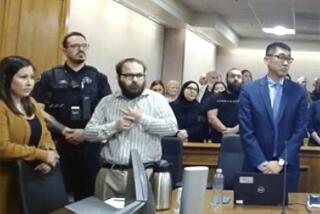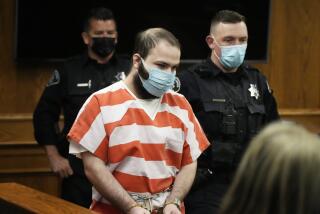Identifying the violent mentally ill is a challenge, experts say
In the best of times and most favorable of circumstances, it’s tricky business to identify whether a person who is mentally ill might become violent, so that those in his path can be protected from potential harm and he can get the treatment he needs.
FOR THE RECORD:
Mental health laws: In the Jan. 11 Section A, an article about identifying potentially violent mentally ill people said that California requires officials to demonstrate that a person has “grave” disability and also poses a danger to himself or others before he can be compelled to get involuntary mental health treatment. California law allows commitment on either of those grounds. —
But with community mental health services stretched taut by budget cuts and growing need, these are not the best of times, say many experts at the intersection of mental health and public safety. Nor were circumstances ideal to single out Jared Lee Loughner — the suspect in Saturday’s Tucson shooting rampage — as a clear-cut case of someone about to become violent.
Loughner’s increasingly bizarre and mistrustful pronouncements, combined with his age — 22 — suggest to many mental health professionals a flowering of mental illness marked by delusional thinking. People diagnosed with schizophrenia, for instance, most often begin showing signs of the illness in their late teens or early 20s, when they suffer episodes of hallucinations and become preoccupied with delusions — for instance, of persecution or conspiracy.
Loughner’s apparent embrace of notions such as mind control, a new currency and “conscience dreaming” — all mentioned in a YouTube posting he reportedly made — speak to a troubled mind but reveal little actual propensity for violence, said Dr. Mark A. Kalish, a forensic psychiatrist who teaches at UC San Diego.
The mentally ill, Kalish noted, are no more likely to engage in violent behavior than members of the general population.
Nonetheless, the shooting has already stirred debate about how to protect the public from violence perpetrated by some among the mentally ill.
Some activists, citing Loughner’s apparent early signs of instability, suggest that state laws need to be broadened to allow involuntary commitment of the potentially violent mentally ill. Most states require that a mental health professional find an individual not only to be severely disabled by mental illness but also to be an imminent danger to himself or others before allowing involuntary commitment to a psychiatric facility.
Others, including many mental health professionals, just as forcefully note that no laws will ensure safety from the violent mentally ill unless state and community mental health services are in place to find them and treat them.
“It isn’t that we don’t know how to get people to help. We’re just not doing it,” said Robert Bernstein, executive director of the Bazelon Center for Mental Health Law in Washington.
“Community-based programs are so underfunded they don’t have the resources to respond appropriately” to evidence that a person may be teetering on the edge of violence, he added. “Every day, people with mental illness are failing to receive services, and every day, people experience preventable crises — are taken to the emergency room or arrested and jailed.”
In many ways, Arizona provides the perfect venue for a new round of debate on violence and mental illness.
In recent years, the state has relaxed the standards that must be satisfied for the involuntary commitment and treatment of the mentally ill. Its laws are now looser than California’s, for example.
Officials in Arizona would have had the latitude to commit Loughner to involuntary psychiatric treatment only by showing that he was “persistently and acutely disabled” by mental illness, said Brian Stettin of the Treatment Advocacy Center in Arlington, Va. The center has strongly lobbied for laws that would make it easier to commit people to psychiatric care against their wishes.
In California, by contrast, officials would have to show “grave” disability and also make a persuasive case that the person posed a danger to himself or others.
In Loughner’s case, the process could have been set in motion if someone — perhaps administrators from Pima Community College — had called a county hotline and prompted the dispatch of a mobile crisis outreach team. Such a team could have urged Loughner to accept care, or evaluated whether care needed to be imposed upon him against his wishes, Stettin said.
But at the same time, Arizona’s budget crisis — among the worst in the nation — has prompted deep cuts in community mental health services. According to Tim Schmaltz, chief executive of Protecting Arizona’s Family Coalition, some 14,000 residents who earn too much to receive Medicaid have lost access to all mental health services, except medications, in the budget cuts.
“You don’t want to be seriously mentally ill in Arizona, unless you’re very poor or very sick,” Schmaltz said.
Money and law aside, gauging someone’s likelihood of acting aggressively requires skill, patience and a bit of timing, experts said.
“When it comes to long-term predictions of risk for violence, all bets are off,” said Dr. Steven E. Pitt, a forensic psychiatrist who consults with the Phoenix Police Department and teaches psychiatry at the University of Arizona School of Medicine.
A skilled mental health professional may have better luck at predicting a person’s likelihood of acting violently in the near term, Pitt said. But “the assessment is only as good as the information that is being shared with you and that is at your disposal, coupled with your clinical judgment,” he added.
And for Jared Lee Loughner, who appeared to have been growing increasingly mistrustful, that information may have been both scant and ambiguous.
Among the red flags a forensic psychiatrist might look for to predict violence are extensive substance abuse, gun ownership, whether a person has a specific target in mind and whether he or she has thought through details of an attack, Kalish said.
But, said Pitt, although these are useful signposts to psychiatrists who are trained in such evaluations, a checklist of the risk factors for violent behaviors will draw in too many people unnecessarily.
“There are thousands who satisfy those conditions, but the majority will never engage in a violent act,” he said.




